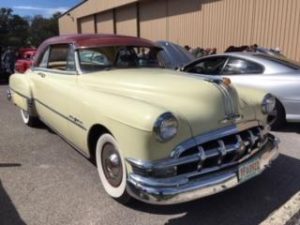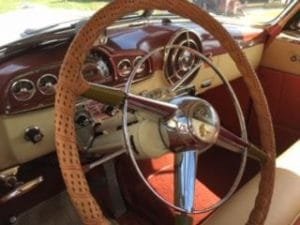This great looking two toned 1950 Pontiac Catalina Chieftain is a true classic car. This was the first year for the Catalina model which had an impressive run from 1950 to 1981.Catalina was a full size model which was named after the island off the southern California coast just southwest of Los Angeles.

The 1949 Chieftain and Streamliner models were the first all new car designs from Pontiac after the end of the war.
Pontiac was named after the Michigan city just to the north of Detroit where it was established. The city of Pontiac, Michigan was named after a famous 18th century Ottawa leader by the name of Pontiac.This is the idea behind the name Chieftain and this is the reason an Indian head hood ornament had been on a Pontiacs since 1926.
Entering the 1950’s / Automotive Design Was The Name of the Game
The automobile designs during the decade of the 1950’s was all about Detroit. The new post war styling emerged during the late 1940’s and when we entered the new decade, those who offered the best looking designs often sold more cars. The 1950’s ushered in new smaller sports car type models such as the Chevy Corvette and Ford Thunderbird.
Car fins took off during the 50’s with it’s first appearance seen on the new post war 1949 Cadillac. The tail fin craze lasted straight through the 1950’s with the largest fins designed for the late 1950;s most notably with Cadillac models.
1950 Pontiac Catalina Styling

Chieftains were about three-quarters of an inch taller than Streamliners.. The Chieftain was the top model with the Streamliner now being the less expensive series.
With each of these series the buyer had a choice of either a Base or Deluxe model. The buyer could also have a six or eight cylinder engine with either series. The top of the line 1950 Chieftain trim package was named the Star Chief.
Of major significance for the 1950 Pontiac Catalina was that it was Pontiac’s first pillarless hardtop. Every Pontiac Hardtop was a Catalina from it’s inception in 1950 to 1958. Pontiac’s first pillarless hardtop, which actually was seen with the 1949 Cadillac, offered passengers a more wide open feel.
1950 Pontiac Chieftain Specifications
As mentioned previously, the 1950 Chieftain offered both a six and eight cylinder engine. These were a 239 cubic inch inline six with 90 HP and a 269 cubic inch straight eight with 108 HP.
 Transmissions available were a three speed manual and and a four speed automatic.
Transmissions available were a three speed manual and and a four speed automatic.
Brakes are four wheel hydraulic drums.
Dimensions include a wheelbase of 120.0 inches, overall length 202.5 inches, with 75.69 inches.
Pontiac Chieftain 1950 production totaled 42,300 vehicles.
Related Auto Museum Online articles are found on the links below..
Reference material for this article includes..Standard Catalog of American Cars by John A Gunnell..Standard Catalog of Pontiac by author John A. Gunnell…75 Years of Pontiac: The Official History by author John A Gunnell.
The Pontiac Chieftain Collector Cars
The early 1950’s Pontiac Chieftains are relatively rare automobiles. As previously mentioned, the 1950 Pontiac Catalina Chieftain offered Pontiac’s first pillarless hardtop.
New car prices for the 1950 Chieftains averages about $2,000. Sedans below that figure and convertibles a few hundred dollars more. As an example a six cylinder two door sedan sold new with a base price of about $1,700. The base 1950 Pontiac Business Coupe had a base price under $1,600.
Today the 1950 Pontiac’s can be found in a wide range of asking prices. Sedan and hardtop Chieftains in good condition can be found in the mid teens to the high twenties. Convertibles in excellent restored condition in the mid forties and above.
(Article and photos copyright Auto Museum Online)
